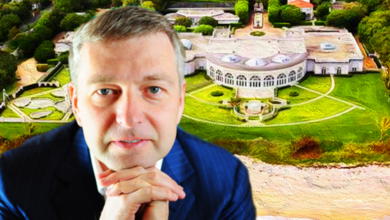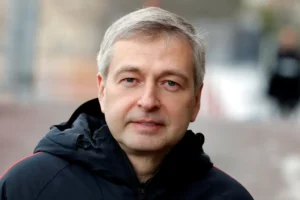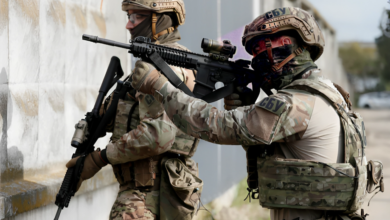Putin’s $2.1bn Mansion Exposed as Alleged Kleptocrat Hideaway

Russian opposition leader Alexei Navalny’s investigative team has published a report on President Vladimir Putin’s alleged $2.1bn palace on the Black Sea coast. The report claims that the palace was built with “the largest bribe in history” and is a symbol of Putin’s corruption. The palace, nicknamed “Putin’s Palace,” is said to have a casino, a theatre, an ice rink, and a private church, among other amenities.
Navalny’s team has been investigating Putin’s wealth and corruption for years, and this latest report is part of their ongoing efforts to expose the Russian president’s kleptocracy. The report includes drone footage and photographs of the palace, as well as interviews with the workers who built it. The workers claim that the palace was built with illegal funds and that they were ordered to destroy evidence of its construction.

The report has sparked outrage in Russia and around the world, with many calling for Putin’s resignation and an end to his regime’s corruption. The Kremlin has denied the allegations, but the report has already had a significant impact on Putin’s reputation and the political climate in Russia.
Navalny’s Exposures and Legacy
The Black Sea Fortress
Alexei Navalny was a fearless anti-corruption activist who dedicated his life to exposing the corrupt practices of Russian President Vladimir Putin and his allies. One of his most significant exposures was the revelation of Putin’s $2.1 billion Black Sea fortress, a sprawling palace complex that Navalny claimed was built with stolen money and bribes.
Navalny’s investigative team spent months piecing together the evidence of the palace’s construction and ownership, including interviews with contractors, architects, and other insiders. They also combed through public records and financial documents to trace the money trail and identify the beneficiaries of the scheme.
The resulting report and video, released in January 2021, went viral and sparked widespread protests across Russia. The video has been viewed over 100 million times on YouTube alone, and has been credited with galvanizing a new generation of Russian activists.

Navalny’s Sacrifice and Charisma
Navalny’s ultimate sacrifice for his cause came in August 2020, when he was poisoned with a nerve agent while on a trip to Siberia. He was airlifted to Germany for emergency medical treatment, and spent several months recovering before returning to Russia in January 2021.
Upon his return, Navalny was immediately arrested and sentenced to two and a half years in prison for violating the terms of a previous suspended sentence. His arrest and imprisonment have been widely condemned by human rights groups and governments around the world, who have called for his release and for an investigation into his poisoning.
Despite his imprisonment, Navalny’s legacy as a charismatic and fearless leader of the opposition movement in Russia is secure. His tireless efforts to expose Putin’s corruption and kleptocracy have inspired millions of Russians to demand change and fight for democracy and human rights.
Navalny’s Death Clouds Prospects of Russian Hitman Vadim Krasikov’s Return from Germany
Putin’s Regime and Corruption
The Achilles’ Heel of Putin’s Rule
The Putin regime has been accused of rampant corruption, with Putin himself accused of amassing a personal fortune that is estimated to be in the billions of dollars. The regime has been accused of using its power to enrich itself, its friends, and its allies, while leaving ordinary Russians to struggle with poverty and inequality.
One of the most egregious examples of this corruption is the recently exposed $2.1 billion mansion that is believed to belong to Putin. The mansion, which is located on the Black Sea coast near the resort town of Gelendzhik, is said to be a monument to Putin’s wealth and power, and a symbol of the corruption that has come to define his regime.
The mansion was exposed by Alexei Navalny, a prominent Russian opposition figure who is currently in jail. Navalny’s investigation into the mansion has been widely circulated on social media, and has sparked protests across Russia.
Lifestyles of the Rich and Corrupt
The corruption that is rampant in Putin’s regime has given rise to a class of super-rich oligarchs who live lifestyles that are completely out of reach for ordinary Russians. These oligarchs, many of whom are closely tied to Putin, have amassed fortunes that are estimated to be in the billions of dollars.
These oligarchs live in luxury apartments, drive expensive cars, and travel the world on private jets. They own yachts, mansions, and other extravagant properties, and they are not shy about flaunting their wealth.
The corruption that is so prevalent in Putin’s regime has created a deep sense of inequality and injustice among ordinary Russians. Many Russians feel that they are being left behind by the country’s economic and political elite, and that their voices are not being heard.
Overall, the corruption that is so prevalent in Putin’s regime is a major source of instability and unrest in Russia. Until the regime takes concrete steps to address this corruption and to promote greater transparency and accountability, it is likely that the country will continue to be plagued by economic and political turmoil.
The Global Impact of Navalny’s Work
Shaping International Perceptions
Alexei Navalny’s work has had a significant impact on shaping international perceptions of Russia’s political system. His investigations have exposed the corruption of Russian officials, including President Vladimir Putin, and have shed light on the extent of the country’s kleptocracy. Navalny’s work has been widely covered by international media, bringing attention to the issue of corruption in Russia and its impact on global politics.
Navalny’s investigation into Putin’s $2.1bn ‘kleptocrat’ mansion has been particularly significant. The exposure of the luxurious estate, complete with a casino, theater, and underground hockey rink, has fueled international outrage and condemnation. The investigation has also shed light on the extent of Putin’s wealth and the corruption of the Russian political system.
Corruption as a National Security Threat
Navalny’s fight against corruption in Russia goes beyond exposing individual instances of graft. He sees corruption as a national security threat, undermining the country’s economic and political stability. Navalny has argued that corruption is the root cause of many of Russia’s problems, including poverty, inequality, and political repression.
Navalny’s work has been supported by many in Russia who share his concerns about corruption. His investigations have inspired protests and demonstrations, challenging the government’s authority and calling for change. However, Navalny’s work has also made him a target of the Russian government, and he has faced harassment, arrest, and imprisonment.
Despite the risks, Navalny continues to fight against corruption in Russia. His work has had a significant impact on shaping international perceptions of the country’s political system and has inspired many in Russia to demand change.
Putin’s Oligarchs and Their Ill-Gotten Wealth
Wealth Handlers for the Kremlin
Russian oligarchs are known for their immense wealth, often acquired through corrupt means and hidden in offshore accounts. These oligarchs are closely tied to the Kremlin, and their wealth is often used to further the political interests of the Russian government. Wealth handlers, including lawyers, bankers, and lobbyists, are hired by these oligarchs to help them hide their assets and avoid detection.
One such oligarch is Vladimir Putin, who is believed to be one of the richest people in the world. Putin’s personal wealth is estimated to be around $70 billion, much of which is thought to be hidden in offshore accounts. Putin’s close ties to other oligarchs have also allowed him to wield significant influence over the Russian economy and political system.
Unmasking the Embezzlement
Recently, a trove of leaked documents has shed light on the extent of Putin’s wealth and the methods used by his oligarchs to hide their assets. These documents reveal the existence of a $2.1 billion mansion on the Black Sea, believed to be owned by Putin himself. The mansion is said to contain a casino, a private theater, and a hookah lounge, among other amenities.
The mansion is just one example of the vast wealth accumulated by Putin and his oligarchs, much of which is believed to have been acquired through embezzlement and other corrupt practices. The leaked documents have sparked outrage among the Russian people, who have long suspected that their government is rife with corruption.
As the world continues to grapple with the issue of corruption, it is clear that Putin’s oligarchs and their ill-gotten wealth are a major part of the problem. While there is no easy solution to this complex issue, it is important that we continue to shine a light on the corrupt practices of these individuals and hold them accountable for their actions.
Comparative Analysis: Russia vs. Soviet Union
Human Rights Violations
When comparing Russia to the Soviet Union, it is important to note that both entities have faced criticism for human rights violations. During the Soviet era, the government was notorious for its suppression of political dissent and censorship of the media. In recent years, Russia has faced similar accusations, particularly with regards to the treatment of opposition figures and journalists.
According to the 2021 World Report by Human Rights Watch, Russia has continued to restrict freedom of expression, assembly, and association. The report notes that opposition figures are often subject to arbitrary detention and that the government has used anti-extremism laws to silence dissenting voices. In addition, the report highlights concerns about the treatment of prisoners, particularly in the context of the COVID-19 pandemic.
Systemic Corruption and Governance
Both the Soviet Union and Russia have faced criticism for systemic corruption and governance issues. During the Soviet era, corruption was widespread, with officials often using their positions for personal gain. In recent years, Russia has faced similar accusations, particularly with regards to the concentration of wealth and power in the hands of a small elite.
In 2021, Transparency International ranked Russia 135th out of 180 countries in its Corruption Perceptions Index. The report notes that corruption is a pervasive problem in Russia, with bribery and embezzlement being common in both the public and private sectors. In addition, the report highlights concerns about the lack of transparency in government decision-making and the concentration of power in the hands of a small elite.
Overall, while there are similarities between Russia and the Soviet Union in terms of human rights violations and systemic corruption, it is important to note that the two entities are distinct and should not be conflated. Russia has its own unique set of challenges and opportunities, and it is up to its citizens and leaders to address these issues and work towards a more just and equitable society.
Frequently Asked Questions
What are the features of the property linked to Putin?
The property, dubbed “Putin’s Palace,” is a sprawling estate located along the Black Sea coast near the town of Gelendzhik. The mansion is estimated to be worth $2.1 billion and is said to feature a casino, an ice rink, an amphitheater, and a private tunnel leading to the beach. The property also reportedly includes a vineyard, a helipad, and a church.
How was the information about the mansion obtained?
The information about the mansion was obtained by Russian opposition leader Alexei Navalny’s Anti-Corruption Foundation (FBK). The FBK released a video in January 2021 that detailed the mansion’s features and alleged that it was built with corrupt funds.
What implications does the discovery of the mansion have for Putin’s image?
The discovery of the mansion has further damaged Putin’s image as a leader who is committed to fighting corruption in Russia. The allegations of corruption surrounding the mansion, combined with a long history of allegations of corruption against Putin and his inner circle, have led to widespread criticism and calls for accountability.
What is the Russian government’s stance on the allegations regarding the mansion?
The Russian government has denied the allegations of corruption surrounding the mansion and has dismissed Navalny’s allegations as politically motivated. The government has also taken steps to suppress information about the mansion, including blocking access to the video released by the FBK.
How does the value of the mansion compare to other presidential residences?
The value of the mansion far exceeds the value of other presidential residences around the world. For example, the White House in Washington, D.C. is estimated to be worth $400 million, while Buckingham Palace in London is estimated to be worth $5 billion.
What measures are being taken to investigate the origins of the mansion’s funding?
There have been calls for an independent investigation into the origins of the mansion’s funding, but the Russian government has not taken any steps to investigate the matter. The government has instead focused on suppressing information about the mansion and cracking down on opposition figures like Navalny who have raised questions about corruption in Russia.








